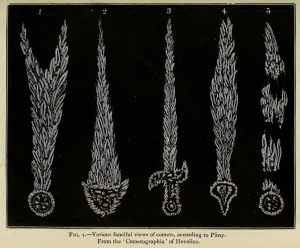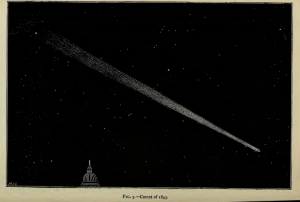By Meg Szydlik, Visitor Services Coordinator
One thing I love about the collections at the Massachusetts Historical Society is the incredible range of different subjects contained within. So as the granddaughter of a particle physicist, I wanted to check out some science-based items and stumbled across The Mysteries of Time and Space, an astronomy book written by Richard A. Proctor in 1883. It promised diagrams and illustrations, and as someone who loves to learn about the stars and the universe, I thought it would be a promising choice for a blog post. I would never claim to be an expert on the mysteries of time and space, but perhaps that is precisely the right mindset to present this fascinating book to you.

The text itself was much less dry than I expected. Although there were many footnotes and lots of technical language, Proctor never had any problem slipping sly comments into his narration and that made the experience much more interesting than the content alone. One of my favorite pieces of commentary was in his section on comets and the end of the world, where he noted that “the year 1001 began, and still the world endured, with every sign of continuing.” His attitude towards astrology and predictions was interesting, because while he frequently raised an eyebrow at these beliefs, and he went through the process of breaking down any links between comets (commonly seen as harbingers of doom) and predicted events, he also seemingly acknowledged that astrology was not inherently wrong. This is a sentiment I have a hard time envisioning my own grandfather echo. It makes me wonder if he was alone in this, or if his contemporaries had similar views and if so, when they shifted.
Though it was clear to me that many advancements have been made since then, I loved reading through the thought process at the time and comparing it to what my understanding is. The creation of far more powerful telescopes, advanced imaging, and of course the launching of spaceships have all dramatically impacted our understanding of the universe in a way Proctor and other scientists of the 1800s could never have imagined in their wildest dreams. The diagrams and images in this book, as beautiful and interesting as they are, can hardly compare to the colorful photographs that were in my textbooks, even in elementary school. Proctor proposes theories about comets and the surface of the sun that I know the answer to! The intervening 140 years have radically changed what we recognize to be true, and yet the scientific process is roughly the same.

Despite the knowledge gap, I think that the spirit of The Mysteries of Time and Space is one I want to emulate. Proctor’s slight irreverence does not detract from his largely solid scientific inquiry. And certainly, as evidenced from the title, there was a sense of wonder at the universe and space that is really stunning and truthfully, a bit inspiring. To quote Proctor once again, “science tries to explain everything, and we must not be too precise in such matters.”

